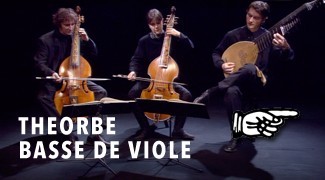The theorbo is a plucked stringed instrument, a big lute invented in Italy at the end of the sixteenth century. The theorbo was used for both basso continuo and as a solo instrument. It was also used for singing accompaniment. In the eighteenth century, in France, we used especially the accompanying theorbo, very imposing instrument. The theorems disappeared during the eighteenth century, before reappearing in the twentieth century with the renewal of the interpretation of early music on period instruments.
The viol or (informally) gamba, is any one of a family of bowed, fretted and stringed instruments with hollow wooden bodies and pegboxes where the tension on the strings can be increased or decreased to adjust the pitch of each of the strings. Frets on the viol are usually made of gut, tied on the fingerboard around the instrument's neck, to enable the performer to stop the strings more cleanly. Frets improve consistency of intonation and lend the stopped notes a tone that better matches the open strings. Viols first appeared in Spain in the mid to late 15th century and were most popular in the Renaissance and Baroque (1600-1750) periods.


